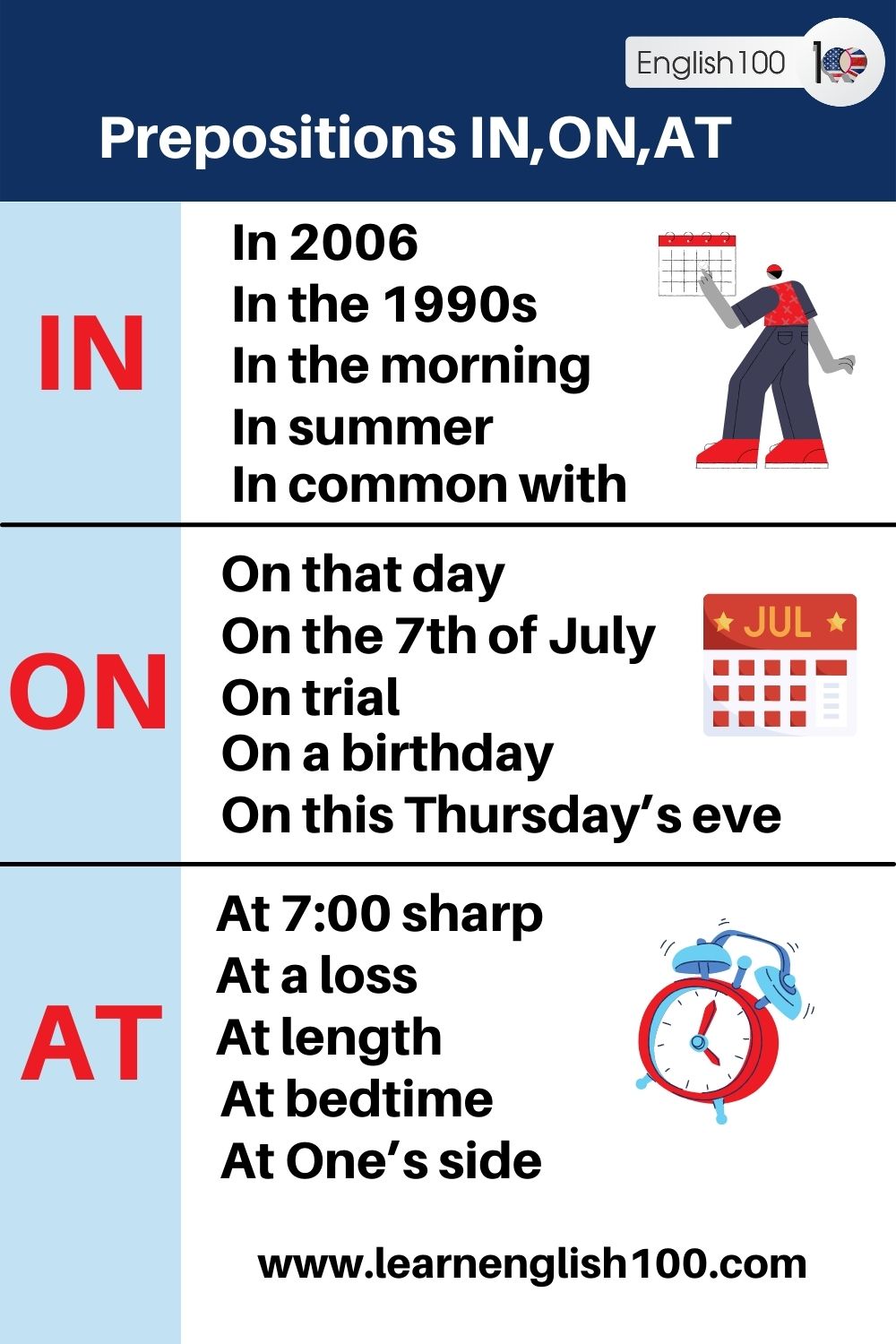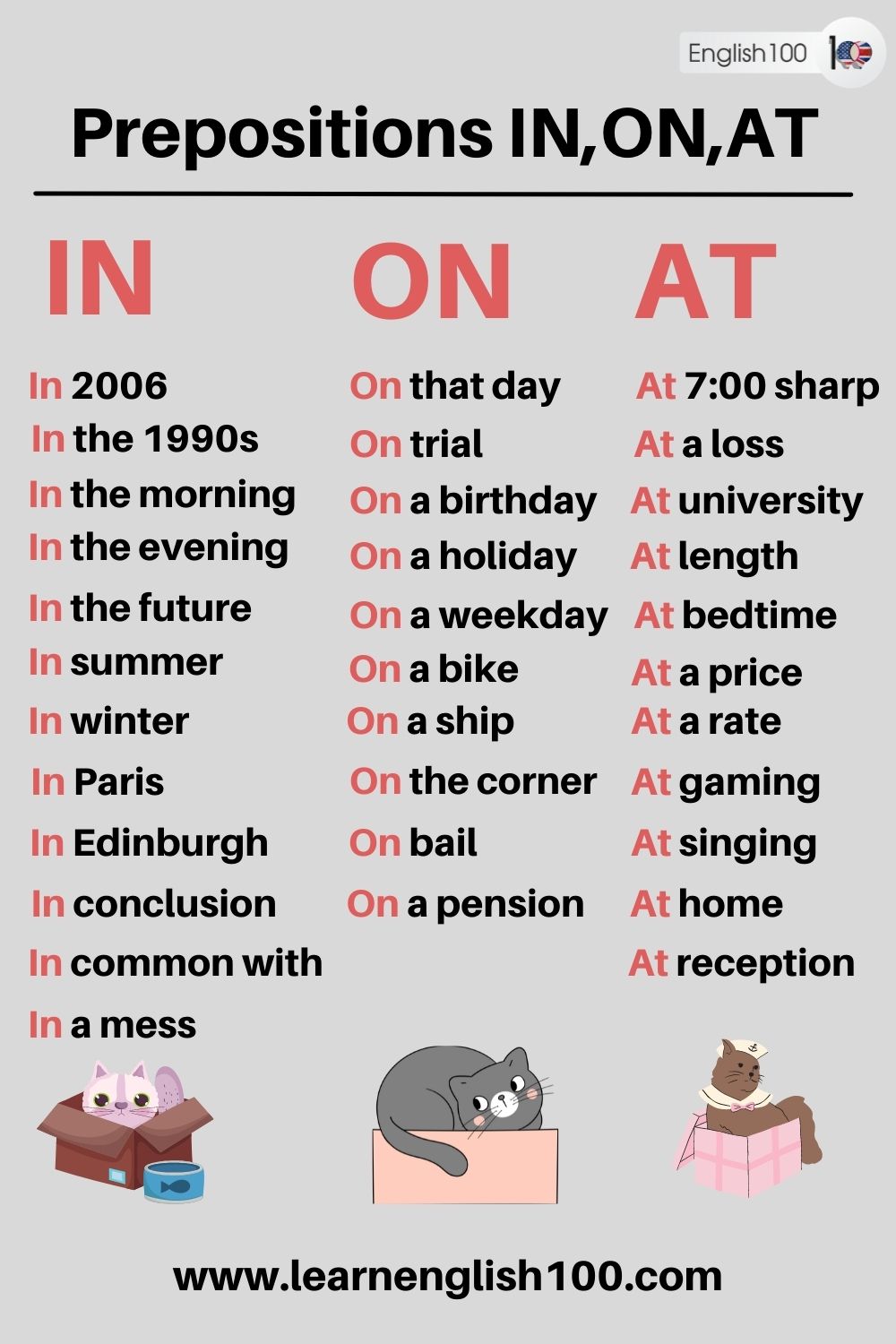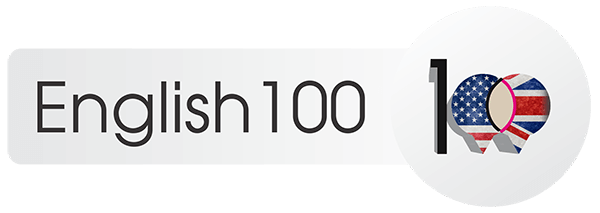

In on at prepositions
Prepositions are essential components of the English language, serving as connectors that establish relationships between words, phrases, and clauses within sentences. Three commonly used in on at prepositions are frequently encountered, but they can be a source of confusion for learners. In this article, we’ll delve into the usage of these prepositions, clarifying when to use in on at prepositions to ensure accurate and effective communication.
In
The preposition “in” is used to indicate location within a defined or enclosed space. Here are some common contexts in which “in” is appropriate:
In 2006
In the 1990s
In Latvia
In the morning
In the afternoon
In the evening
In the future
In summer
In winter
In autumn
In fall
In spring
In the Easter holiday
In Paris
In Edinburgh
In conclusion
In common with
In a mess
On
The preposition “on” indicates surface contact or position. Here are common instances where “on” is the appropriate choice:
Physical Contact: Use “on” to describe something in direct contact with a surface.
Example: “The book is on the table.”
Days and Dates: “On” is used with specific days of the week or specific calendar dates.
Example: “We’ll meet on Monday.”
Transportation: Employ “on” when referring to modes of transportation, such as being on a bus, plane, or train.
Example: “I’ll be on the flight tomorrow.”
On that day
On the 7th of July
Onboard
On trial
On a birthday
On a holiday
On this Thursday’s eve
On a weekday
On a bike
On a plane
On a ship
On the corner
On bail
On a pension
On a certain scale
On an expedition
At
The preposition “at” is employed to specify a particular point or location. Here are common contexts for using “at”:
Specific Locations: Use “at” for precise, named locations or points.
Example: “She’s waiting at the corner.”
Events and Gatherings: “At” is used with events, gatherings, or specific times.
Example: “We’ll meet at the concert.”
Addresses: Employ “at” when referring to a specific address.
Example: “The party is at 123 Main Street.”
At 7:00 sharp
At a loss
At university
At length
At bedtime
At a price
At a rate
At dinner time
At gaming
At singing
At One’s side
At home
At a conference
At reception
Prepositions contribute to the flexibility and fluidity of English sentence structure. They allow you to convey complex ideas by connecting various elements in a sentence. Without prepositions, sentences could become rigid and monotonous. 1
More about in on at prepositions
English prepositions are highly important due to their function of connecting the parts of every single sentence. The meaning of any sentence and the target of every verb can’t be delivered without this connection carried out by the preposition.
The difference in their use is quite simple and easy to learn. It is a range in which we use the preposition “in” when we have a wide span of time, while “on” is used precisely when there is a specific day that is being mentioned. However, when we desire to achieve even more precision, we resort to “at” that pinpoints a specific time or place with surgical precision.
There is also as we see the metaphorical use of all the previous three prepositions, in on at prepositions. By metaphorical use, we mean that those prepositions do not necessarily pertain to physical space rather they can be used to express general non-materialistic states.
For example, in an uproar at his recent activities, this phrase represents a psychological state by a group of people who are infuriated by certain acts committed by a person. The same applies to the other two prepositions.
You can see that in the following examples about in on at prepositions
They worked in silence. It does mean that they are working amidst a state of silence. Silence is being materialized here as something to be in, but it is still something that you cannot grasp, see, hear, or taste. It is only an obscure feeling of the voidness of sound. It is the absence of sounds, but it does not mean we can catch it. See also https://bit.ly/3Fa7nNZ
Karl built his hypothesis on false facts. The facts are to be understood, they are being materialized by blocks in this sentence, but that shows you too how the preposition on can work even in sentences with no physical layout.
Common Mistakes to Avoid
Confusing “in” and “on” when referring to time. Remember that “in” is used for larger time periods (e.g., months, seasons), while “on” is used for specific days and dates.
Using “in” for surfaces or objects in contact with surfaces. Use “on” for surface contact.
Overusing “at” when “in” or “on” is more appropriate for indicating location.
FAQ about in on at prepositions
What are the prepositions in on and at?
Prepositions are words that establish relationships between other words, phrases, or clauses within sentences. Here are the common uses of the prepositions “in,” “on,” and “at”:
1. In:
Location: “In” is used to indicate that something is inside a defined or enclosed space. Example: She is in the room.
Enclosed Spaces: It is used with spaces enclosed by boundaries, such as rooms, buildings, or containers. Example: The book is in the box.
Time Periods: “In” is used with months, seasons, years, and parts of the day to indicate a time period. Example: I’ll see you in the evening.
2. On:
Surface Contact: “On” is used to describe something in direct contact with a surface. Example: The pen is on the desk.
Days and Dates: It is used with specific days of the week or specific calendar dates. Example: We have a meeting on Wednesday.
Transportation: “On” is used when referring to modes of transportation like buses, trains, or planes. Example: I’ll be on the flight tomorrow.
3. At:
Specific Locations: “At” is employed to specify a particular point or location. Example: He is waiting at the bus stop.
Events and Gatherings: It is used with events, gatherings, or specific times. Example: We’ll meet at the party.
Addresses: “At” is used when referring to a specific address. Example: The conference is at 123 Main Street.
These prepositions serve to provide context, location, and time references in sentences, helping to convey precise meanings and relationships within language.
What are 5 examples with on?
Here are five examples of sentences using the preposition “on”:
The book is on the shelf.
We had a picnic on a sunny day.
The painting is hanging on the wall.
She left a note on the kitchen table.
The cat is sitting on the windowsill.
In these sentences, “on” is used to indicate surface contact or position.
To conclude, understanding the distinctions between in on at prepositions is vital for clear and precise communication in English. By mastering the appropriate usage of these prepositions, you can convey location, time, and position accurately, enhancing your proficiency in the language and ensuring that your messages are well-received and understood by others.
We hope that you enjoyed this article. Follow us for more information and examples on those prepositions and other prepositions, but more importantly for more fun pieces of information in all domains! Read more articles http://ow.ly/1nHG50HZBJ8
References:
- Bendwebs_Admin. (2023, October 27). Prepositions – small (but important) words! SciTechEdit International.
